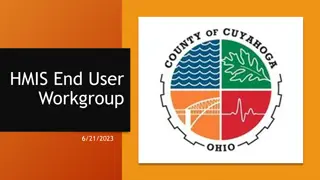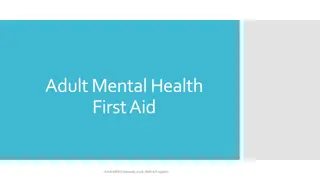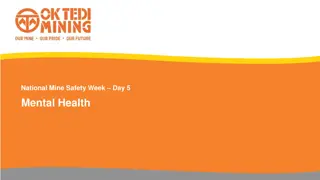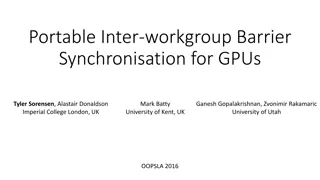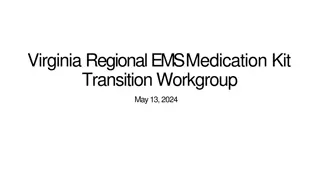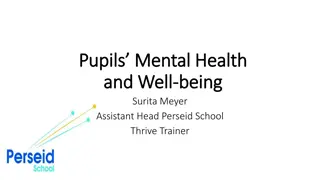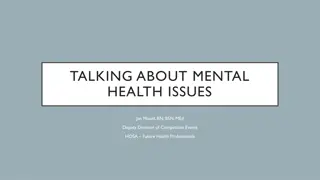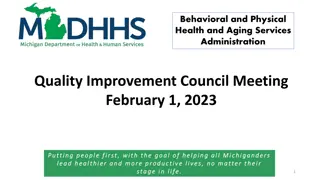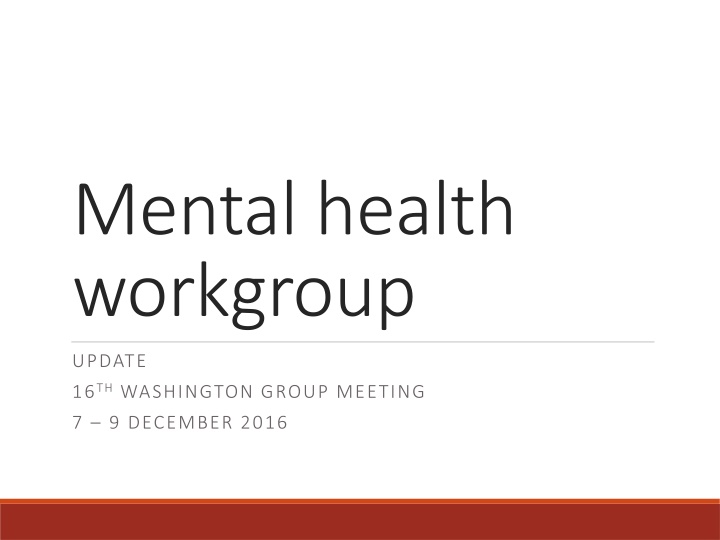
Update on Mental Health Workgroup Meeting
The update covers the purpose, strategies, and discussions from the 16th Washington Group meeting focusing on functional limitations associated with mental disorders. It includes sessions on disability measures, survey analyses, and ensuring adequate coverage of mental disorders. The workgroup aims to review performance, add further measures, and develop strategies for effective outcomes. A scoping review, search strategy, and analysis of data are key components in evaluating functional difficulties and enhancing the Extended Set measures for comprehensive assessment.
Download Presentation

Please find below an Image/Link to download the presentation.
The content on the website is provided AS IS for your information and personal use only. It may not be sold, licensed, or shared on other websites without obtaining consent from the author. If you encounter any issues during the download, it is possible that the publisher has removed the file from their server.
You are allowed to download the files provided on this website for personal or commercial use, subject to the condition that they are used lawfully. All files are the property of their respective owners.
The content on the website is provided AS IS for your information and personal use only. It may not be sold, licensed, or shared on other websites without obtaining consent from the author.
E N D
Presentation Transcript
Mental health workgroup UPDATE 16THWASHINGTON GROUP MEETING 7 9 DECEMBER 2016
Session structure 1. Overview of purpose and strategies to meet the purpose 2. Update on scoping review of functional limitations associated with common and severe mental disorders 3. Review of analyses comparing WG ES Affect data to that for other MH scales 4. Discussion on work so far and suggestions for way forward
Purpose 1. Ensure adequate coverage of common and severe mental disorders in the WG disability measures Symptoms are covered by Affect questions on anxiety and depression Functional consequences of these symptoms activity limitations, participation restrictions and effect of environmental factors; e.g. difficulty with social interactions, negative impact of stigma, etc. 2. Add further measures to the WG Extended set if coverage is not adequate for functional consequences 3. Review the performance of the WG Affect (anxiety and depression) measures in the Extended Set relative to common scales used in surveys
Strategy for ensuring adequate coverage 1. Scoping review of activity limitations, participation restrictions and environmental barriers commonly associated with common and severe mental disorders 2. If coverage is not adequate, develop a strategy to add 1 3 measures to the Extended Set and to environmental factors module (being developed) Review existing survey measures and scales Select and test additional measures for the WG Extended Set OR Develop new measures
Scoping review: functioning and mental disorders 1. Do the search and collect all the articles identified 2. Review the collected articles for: Type and severity of mental disorder Nature of activity limitation, participation restriction and environmental barriers 3. Analyze the data to extract: Typical profiles of functioning for different types and severity of mental disorders Differences by region, income status of countries, age, urban/rural 4. Compare the common functional difficulties to the WG Short and Extended sets
Search strategy 1. Search for articles: Electronic databases Manual searches 2. Reviewing the documents Review titles and exclude non-relevant articles Review abstracts of remaining articles and exclude non- relevant ones Review full text of articles and exclude non-relevant ones 3. Extract information from all relevant articles Excel spreadsheet Review trends in data
Summary of articles found and analysed 1. Collected and reviewed 83 full text articles 2. 60 were excluded as not relevant (reporting on MH scale validation, about policy, not reporting clear functional limitation examples, etc.) 3. All English papers (for now) 4. 23 were reviewed as relevant: Focused on common or severe mental illness Described functional status directly related to the mental illness Identified clear domains that are difficult for people with mental illness 5. Excluded: Intellectual impairments Alcohol and drug abuse dementia
Primary types of mental disorder/ illness addressed (i.e. the diagnosis) 1. 2. 3. 4. 5. 6. 7. 8. 9. Anxiety Severe anxiety Depression (mild to moderate) Major depression Post Traumatic Syndrome Disorder (PTSD) Psychosis (e.g. schizophrenia) Bipolar mood disorder Obsessive Compulsive Disorder (OCD) Other (e.g. personality disorder, somatoform disorders, phobia, panic disorder)
Types of disorders covered 10 9 8 7 6 Number of papers 5 4 3 2 1 0 Anxiety disorder Mild to moderate depressive disorder Post-traumatic stress disorder Schizophrenia Major depressive Bipolar mood disorder Obsessive Compulsive disorder SMDs general Other disorder
Description of studies reviewed URBAN VS RURAL WB COUNTRY CLASSIFICATION 20 14 18 12 16 Number of papers 10 14 12 8 Number of papers 10 6 8 6 4 4 2 2 0 0
Study type 12 10 8 Number of papers 6 4 2 0 Survey qualitative clinical study systematic or general review meta-analysis
SEVERE ANXIETY ANXIETY AL/PR Emotional state Memory and thinking Social relationships Work Self care Communication Activity Limitations/Participation Restrictions (AL/PR) Social relationships Social Role functioning Work Environmental factors (EFs) EFs ?? Low social support
MILD/MODERATE DEPRESSION MAJOR DEPRESSION AL/PR Mobility: move from place to place (e.g. to market) Work Social relationships Community life Memory and thinking Executive function Attention difficulties Verbal and visual memory Language functions EFs ?? AL/PR Social relationships Leisure Social Role functioning Work and Household activities Mobility Self care EFs ??
Psychosis AL/PR: EFS: Attitudes: Public image of MI (e.g. being violent) Hostile social climate No differentiation between MI and intellectual impairment Self care Communication Social relationships (including intimate partners) Services: Poor quality of mental health services Inadequate help in crisis situations Inequitable distribution of resources in health care system Work Social role functioning Physical functioning Four dimensions of stigma: Interpersonal interaction, The public image of mental illness, Structural discrimination, and Access to social services Memory and thinking Executive function Attention difficulties Verbal and visual memory
Bipolar mood disorder AL/PR: EFS: ?? Self-care (less affected) Social relationships Communication/language functions Work Leisure Household/domestic tasks Memory and thinking Executive function Attention difficulties Verbal and visual memory Likely to be similar to Psychosis
Obsessive Compulsive Disorder (OCD) AL/PR: EFS: Sleep disturbance (insomnia), Formal and information discrimination Work/Occupational Educational functioning Social Relationships (family and friends) Social Role functioning Leisure Household/domestic activities
Severe mental disorders in general AL/PRs 1. Domestic/household activities: washing clothes, preparing food, daily routine 2. Self-care: washing self, carrying out daily routine 3. Social functioning and relationships/Communication: family, friends, community 4. Communication: Verbal fluency 5. Memory and thinking (Executive function, Attention difficulties, Verbal and visual memory) 6. Controlling behaviour: getting upset, conflict with others, misinterpretations, violent 7. Mobility 8. Formal work 9. Informal work (farming) and domestic activities 10. Community Activities
Severe mental disorders in general EFs 1. Attitudes: community beliefs and attitudes stigma family/caregivers attitudes lowered expectations of the person with SMD exaggerated fear (unnecessary restraint) 2. Support: Lack of support (no autonomy or freedom) Professionals Family 3. Poverty 4. Medication Personal factors: 1. Underestimating self 2. Impact of medication side effects
Some recommendations Additional domains for WG Extended set 1. Social functioning and relationships (family, friends and community) More detailed domains 1. Communication: Verbal fluency 2. Memory and attention Environmental factors 1. Attitudes/Stigma 2. Services 3. Support (including medication)
What next? What next?
Workplan for 2017 1. Further review of journal articles non-English 2. Further analyses of data sets More detailed trends with covariates (physical co-morbidities, smoking, etc.) Comparison with other MH measurement scales 3. Review of existing measures to cover additional and more detailed domains 4. Analysis of typical profiles for people with SMDs Functional profile predicting a diagnosis Description of typical profiles Determine extent to which WG SS and WG ES currently identify people with SMDs


